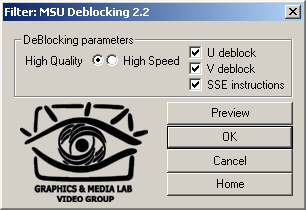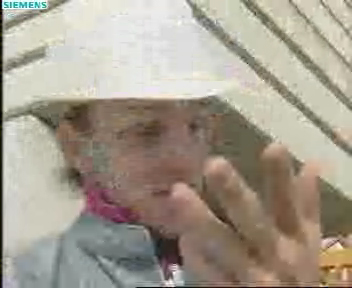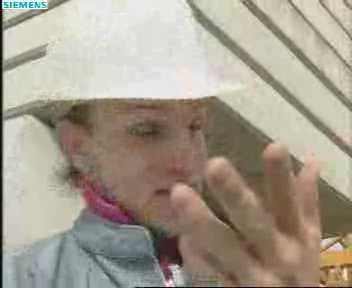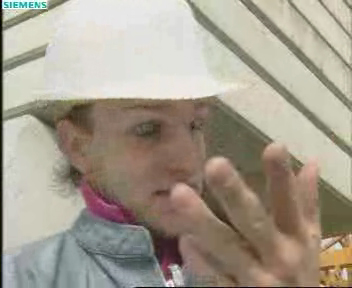VirtualDub MSU Deblocking Filter v2.2
- Algorithm: Dmritriy Vatolin
- Implementation: Sergey Grishin
Filter is intended for recovering quality of video ripped from DVD (for example, when it contains 4 hours of video data), VideoCD or after decompressing by H.261, H.263, DivX 3, DivX 4, XviD.
Filter automatically determines the blockiness’s strength on the frame and in the concrete part of it, preserving the maximum of details. Thus, filter will process marginally when on scenes with slow motion, while it will smooth very hard in the case of fast motion in the same film.
The main advantage of the filter is that it raises the integral quality in the most widespread PSNR metric in comparison with original film. That is, a film after decompression in comparison with original achieves the lower quality than a film after decompression and deblocking. (But for all that the original film is not used nowise, only decompressed data is used.)
What’s new in version v2.0?
New version in “High quality” mode works 2.1 times faster than v1.2 and 2.4 times faster in “High speed” mode.
- Conversions of color spaces optimized (SSE).
- Horizontal deblocking optimized (ММХ).
- New option of adjusting speed/quality parameter are available (25% speed improvement).
Quality raised.
- Algorithm of automatic detection of blockiness level improved (more details are preserved).
- Chrominance components processing significantly improved.
- All basic deblocking methods changed. Discontinuities along borders of blocks is now absent, image looks more “naturally”.
What’s new in version v2.1?
- SSE optimization used only if it is supported by processor and OS
- Bug fixed: log is not created now
- Bug fixed: there is now no crashes during processing of frequencies in high resolution
What’s new in version v2.2?
- Bug fixed: automatic SSE support detection is now works correctly
- Possibility of manual SSE instructions disabling in case SSE is supported by CPU and OS
Settings
Filter’s interface allows to adjust the quality and the speed of processing. In “High speed” mode optimized version of horizontal deblocking works, which has slightly lower quality in comparison to “High quality” mode. In “High speed” mode filter works 25% faster. Using U-deblock & V-deblock it is possible to turn on/off the processing of chrominance components (turning these parameters on noticeably raise the visual quality). Using “SSE instructions” parameter it is possible to disable SSE if it is supported by the CPU and OS.
Filter supports Job Control, and it can be used from AviSynth. Example:
LoadVirtualDubPlugin("...\VirtualDub\plugins\MSU_DeBlock.vdf","Deblock", 0)
clip=AVISource("...\clip_input.avi", false, "RGB24")clip.ConvertToRGB32.Deblock(1, 1, 1, 1)
First filter parameter - U component deblocking
Second filter parameter - V component deblocking
Third filter parameter - high quality mode
Forth filter parameter - SSE instructions utilization

Examples
Let’s consider the maintenance of the filter by the example of the test video sequence called “Battle”(The part of film “Terminator 2”). Case of very low bitrate:
 Frame before processing |
 The same frame after processing by version 1.2 |
 The same frame after processing by version 2.0 |
The next sample is an example of processing the sequence “foreman” (frame 152, compressed using Xvid with bitrate option 50kbs):
 Frame before processing |
 The same frame after processing by version 1.2 |
 The same frame after processing by version 2.0 |
Examples of filter performance on sequence “battle”. Samples are placed in order of increasing of bitrate (frame 65, compressed using Xvid with bitrate option 100, 300, 500kbs):
 Frame before processing |
 The same frame after processing |
 Frame before processing |
 The same frame after processing |
 Frame before processing |
 The same frame after processing |
Let’s consider the maintenance of the filter by the example of test sequence called “Foreman”(frame 155, compressed using Xvid with bitrate option 50, 75, 100kbs):
 Frame before processing |
 The same frame after processing |
 Frame before processing |
 The same frame after processing |
 Frame before processing |
 The same frame after processing |
There is two branches on the graph: the first (Blocked) corresponds to the film after decompression, the second one (MSU Deblocking) - to the film after decompressing and deblocking. The Y-direction is graduated by Y-PSNR metric of the film in comparison to an original one, noncompressed film. The X-direction is graduated by the bitrate (kbit/sec). Thus, it is easy to see that the quality of the film after deblocking is noticeably higher, at that the lower bitrate the higher difference.
 Raising of the quality after deblocking |
 Raising of the quality after deblocking |
License
Program license for non-commercial usage
Download
See also
Contacts
- For common questions about filter’s work please contact us: video@graphics.cs.msu.ru
- For commercial license of this filter (commercial usage is not free) please contact us: video-licensing@graphics.cs.msu.ru
-
MSU Benchmark Collection
- Video Colorization Benchmark
- Video Saliency Prediction Benchmark
- LEHA-CVQAD Video Quality Metrics Benchmark
- Learning-Based Image Compression Benchmark
- Super-Resolution for Video Compression Benchmark
- Defenses for Image Quality Metrics Benchmark
- Super-Resolution Quality Metrics Benchmark
- Deinterlacer Benchmark
- Metrics Robustness Benchmark
- Video Upscalers Benchmark
- Video Deblurring Benchmark
- Video Frame Interpolation Benchmark
- HDR Video Reconstruction Benchmark
- No-Reference Video Quality Metrics Benchmark
- Full-Reference Video Quality Metrics Benchmark
- Video Alignment and Retrieval Benchmark
- Mobile Video Codecs Benchmark
- Video Super-Resolution Benchmark
- Shot Boundary Detection Benchmark
- The VideoMatting Project
- Video Completion
- Codecs Comparisons & Optimization
- VQMT
- MSU Datasets Collection
- Metrics Research
- Video Quality Measurement Tool 3D
- Video Filters
- Other Projects
